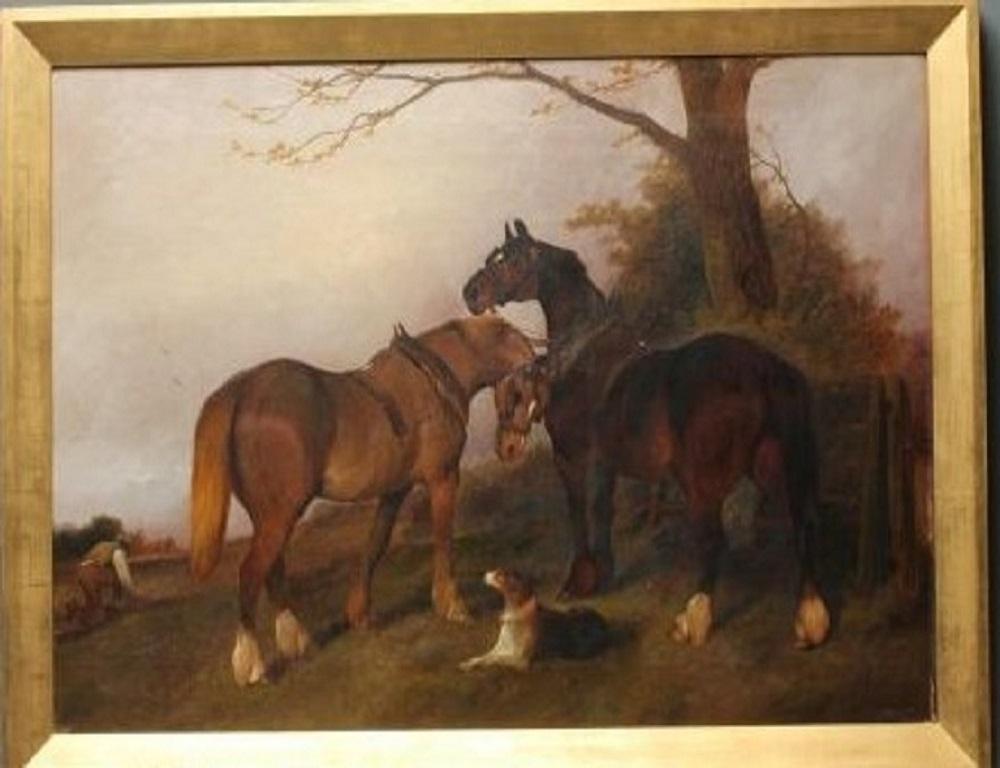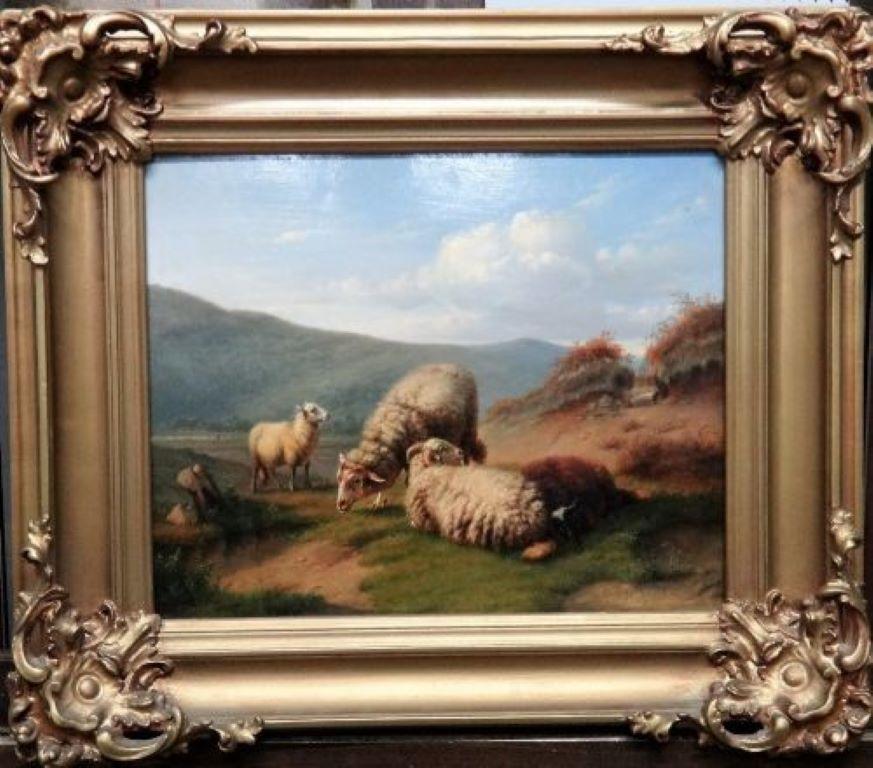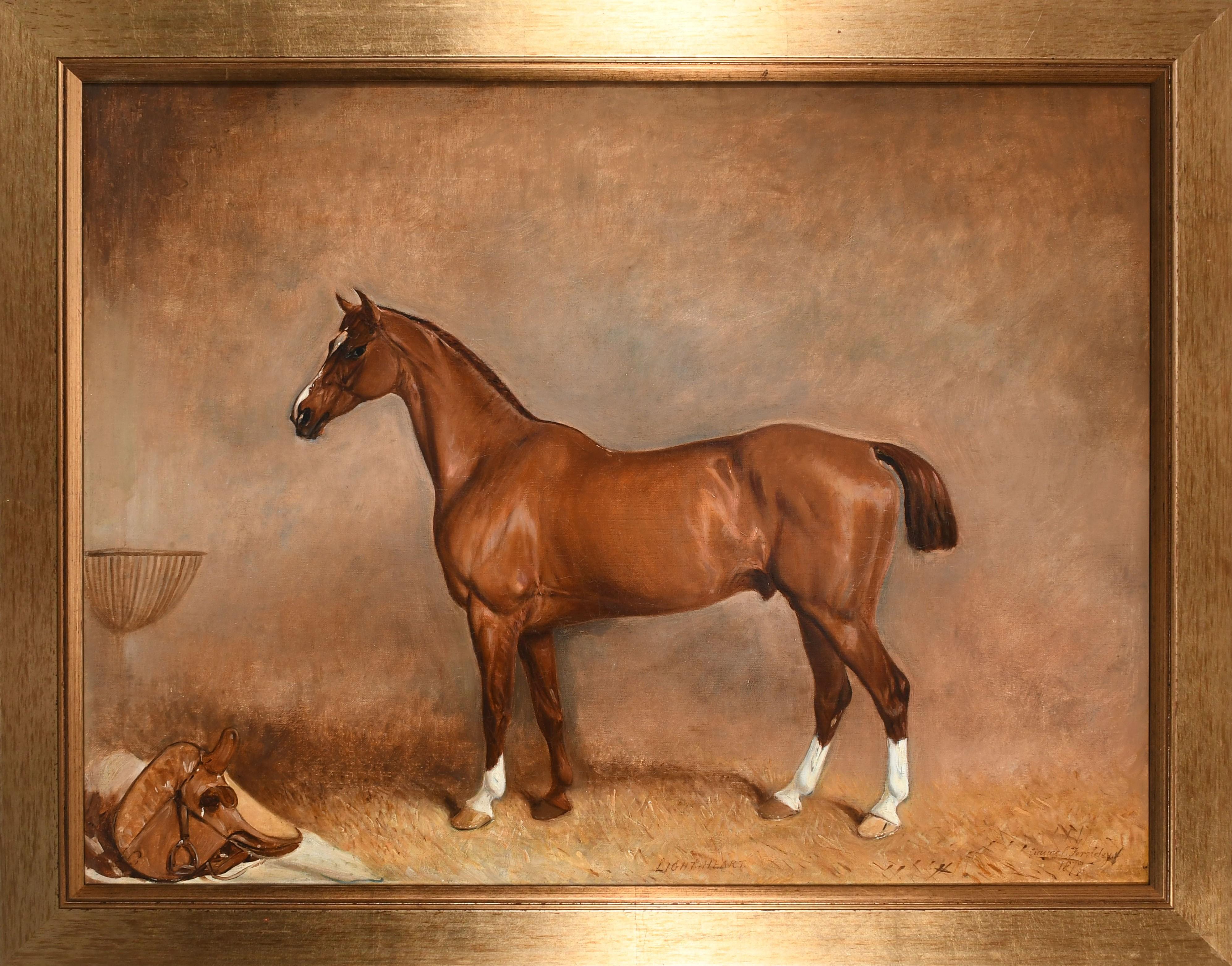Items Similar to Rabbits Dove and Guinea Pig in an Interior - Italian Old master art oil painting
Want more images or videos?
Request additional images or videos from the seller
1 of 14
Rabbits Dove and Guinea Pig in an Interior - Italian Old master art oil paintingCirca 1650
Circa 1650
About the Item
This superb Italian 17th century Old Master animal oil painting is attributed to Baroque artist Giovanni Agostino Cassana. Painted circa 1650 the composition is of two rabbits, a guinea pig and a dove in an interior. The two rabbits, one brown one grey are in the immediate foreground, head to head eating something and the dove is standing to their right. The brown and white guinea pig is sitting above and behind them. As the background is dark the animals really stand out and there is superb detail in their respective fur and feathers. This is a charming Italian Old Master animal oil painting and an excellent example of Cassana's work.
Provenance. Scottish estate.
Condition. Oil on canvas, 24 inches by 20 inches and in good condition.
Frame. Housed in a ebonised frame, 32 inches by 28 inches, in good condition.
Giovanni Agostino Cassana (c.1658 – 6 May 1720) was an Italian painter of the Baroque period. He was a son of Giovanni Francesco Cassana and an elder brother of Niccolò and Giovanni Battista. He was born at Venice, and was initially instructed by his father. In 1670 he worked at the court of Ferdinando de' Medici in Florence and travelled regularly between the two cities, but spent at least the years 1718–1720 in Genoa, where he later died. He painted portraits with some success, but preferred painting animals in the style of Antonio Maria Vasallo, Benedetto Castiglione, and Joannes Fyt, a style which he learned from Jacques van de Kerckhove in Venice. Paintings of still life subjects are found in the collections at Florence, Venice, and Genoa.
- Attributed to:Giovanni Agostino Cassana (1658 - 1720)
- Creation Year:Circa 1650
- Dimensions:Height: 28 in (71.12 cm)Width: 32 in (81.28 cm)Depth: 2 in (5.08 cm)
- More Editions & Sizes:32 inches by 28 inches. Price: $10,190
- Medium:
- Movement & Style:
- Period:1650-1659
- Condition:
- Gallery Location:London, GB
- Reference Number:1stDibs: LU853113277742
About the Seller
5.0
Platinum Seller
These expertly vetted sellers are 1stDibs' most experienced sellers and are rated highest by our customers.
1stDibs seller since 2018
398 sales on 1stDibs
Typical response time: <1 hour
- ShippingRetrieving quote...Ships From: London, United Kingdom
- Return PolicyA return for this item may be initiated within 14 days of delivery.
More From This SellerView All
- Italian Greyhound and Friends - Italian 17thC Old Master dog art oil paintingBy Francesco FieravinoLocated in London, GBThis stunning Old Master 17th century oil portrait painting is attributed to Francesco Fieravino, an artist famous in his day for still lifes and carpets. This painting which dates t...Category
17th Century Old Masters Animal Paintings
MaterialsCanvas, Oil
- Portrait of a Boy with Bird - British 17th century art Old Master oil paintingLocated in London, GBThis stunning 17th century Old Master portrait oil painting is attributed to Godfrey Kneller. Painted circa 1680 it is a superb full length portrait of a blonde haired boy holding a struggling bird. He is bare foot and dressed in a white shirt with gold shawl around him. In the background is a blue drape. There is lovely detail and brushwork in his facial features and vibrant colouring. This a superb 17th century Old Master oil painting housed in a lovely frame. Provenance. Two ascribed labels verso Christie's stamp verso. . Condition. Oil on canvas in good condition, 36 inches by 28 inches approx. Frame. Housed in an ornate frame, 43 inches by 35 inches approx. Sir Godfrey Kneller, 1st Baronet (born Gottfried Kniller; 8 August 1646 – 19 October 1723), was the leading portrait painter in England during the late 17th and early 18th centuries, and was court painter to English and British monarchs from Charles II to George I. Kneller was born Gottfried Kniller in the Free City of Lübeck, the son of Zacharias Kniller, a portrait painter. Kneller studied in Leiden, but became a pupil of Ferdinand Bol and Rembrandt Harmenszoon van Rijn in Amsterdam. He then travelled with his brother John Zacharias Kneller, who was an ornamental painter, to Rome and Venice in the early 1670s, painting historical subjects and portraits in the studio of Carlo Maratti, and later moved to Hamburg. The brothers came to England in 1676, and won the patronage of the Duke of Monmouth. He was introduced to, and painted a portrait of, Charles II. In England, Kneller concentrated almost entirely on portraiture. In the spirit of enterprise, he founded a studio which churned out portraits on an almost industrial scale, relying on a brief sketch of the face with details added to a formulaic model, aided by the fashion for gentlemen to wear full wigs. His portraits set a pattern that was followed until William Hogarth and Joshua Reynolds. Nevertheless, he established himself as a leading portrait artist in England. When Sir Peter Lely died in 1680, Kneller was appointed Principal Painter in Ordinary to the Crown by Charles II. For about 20 years (c.1682-1702) he lived at No. 16-17 The Great Piazza, Covent Garden. In the 1690s, Kneller painted the Hampton Court Beauties depicting the most glamorous ladies-in-waiting of the Royal Court for which he received his knighthood from William III. He produced a series of "Kit-cat" portraits of 48 leading politicians and men of letters, members of the Kit-Cat Club. Created a baronet by King George I on 24 May 1715, he was also head of the Kneller Academy of Painting and Drawing 1711–1716 in Great Queen Street, London, which counted such artists as Thomas Gibson amongst its founding directors. His paintings were praised by Whig members including John Dryden, Joseph Addison, Richard Steele, and Alexander Pope. On the landing in Horsham Museum hang works of art from the Museum's extensive painting collection, featuring a large 18th-century portrait of Charles Eversfield and his wife, of Denne Park House. In the painting Eversfield is giving his wife some violets which signifies fidelity, love and honesty. It is likely that the picture was cut down at some time as it was unusual to stop just below the knee. It may have been painted by more than one person: someone who specialised in clothing, another in drapes, and so on, with perhaps Kneller painting the heads, for it was the portraits that gave the sitters their identity, everything else is rather formulaic. He married a widow, Susanna Grave, on 23 January 1704 at St Bride...Category
1680s Old Masters Portrait Paintings
MaterialsOil
- Portrait of William Stonestreet - Dutch Golden Age 17thC art oil paintingLocated in London, GBThis superb Dutch Golden Age portrait is attributed to circle of Dutch artist Wybrand Simonsz de Geest. Painted in 1666 it is a full length portrait of a young William Stonestreet. H...Category
1660s Old Masters Portrait Paintings
MaterialsOil
- Boy with Guinea Pig - British Victorian animal art male portrait oil paintingBy Henry Turner MunnsLocated in London, GBThis charming British Victorian genre oil painting is by noted exhibited artist Henry Tuner Munns. It was painted in 1865 in realist palette with superb detail in the young boy's fac...Category
19th Century Old Masters Portrait Paintings
MaterialsOil
- Arcadian Italian Landscape - Old Master 17thC French oil painting herdsman sheepBy (Attributed to) Gaspard DughetLocated in London, GBA delicate oil on canvas landscape capriccio of an Arcadian landscape with figures and sheep and goats in the foreground. A stormy sky and blasted tree populate the landscape and the...Category
17th Century Old Masters Landscape Paintings
MaterialsOil
- Shepherd with Animals in Landscape - Dutch Old Master art pastoral oil paintingBy Nicolaes BerchemLocated in London, GBThis lovely Dutch Old Master oil painting is attributed to noted Dutch artist Nicholaes Berchem. Painted circa 1665 it is a charming pastoral scene of a shepherd and his animals including sheep, goats, donkey and cows and of course his trusty dog. They are all resting beneath trees while he looks on attentively. The light in the sky and the light and shadows on the animals is beautiful. A really superb example of Dutch Old Master art with great detail. Provenance. Surrey estate. Christies stamp verso. Condition. Oil on canvas, 38 inches by 32 inches and in good condition. Frame. Housed in a complementary gilt frame, 46 inches by 30 inches and in good condition. Nicolaes Pieterszoon Berchem (1620-1683) was a highly esteemed and prolific Dutch Golden Age painter of pastoral landscapes, populated with mythological or biblical figures, but also of a number of allegories and genre pieces. He was a member of the second generation of "Dutch Italianate landscape" painters. These were artists who travelled to Italy, or aspired to, in order to soak up the romanticism of the country, bringing home sketchbooks full of drawings of classical ruins and pastoral imagery. His paintings, of which he produced an immense number, (Hofstede de Groot claimed around 850, although many are misattributed), were in great demand, as were his 80 etchings and 500 drawings. His landscapes, painted in the Italian style of idealized rural scenes, with hills, mountains, cliffs and trees in a golden dawn are sought after. Berchem also painted inspired and attractive human and animal figures (staffage) in works of other artists, like Allaert van Everdingen, Jan Hackaert, Gerrit Dou, Meindert Hobbema and Willem Schellinks. Born in Haarlem, he received instruction from his father Pieter Claesz, and from the painters Jan van Goyen, Pieter de Grebber, Jan Baptist Weenix, Jan Wils and Claes Cornelisz. Moeyaert. According to Houbraken, Carel de Moor told him that Berchem got his name from two words "Berg hem" for "Save him!", an expression used by his fellows in Van Goyen's workshop whenever his father chased him there with the intent to beat him. No trip or Grand Tour by Berchem was documented by Houbraken though he mentioned another story about the "Berg hem!" nickname which came from Berchem's conscription as a sailor; the man in charge of impressment knew him and sent him ashore with the words "Save him!". Today his name is assumed to come from his father's hometown of Berchem, Antwerp. According to the RKD he traveled to Italy with Jan Baptist Weenix, whom he called his cousin, in 1642–5. Works by him are signed both as "CBerghem" and "Berchem". In 1645 he became a member of the Dutch reformed church and married the year after. According to Houbraken he married the daughter of the painter Jan Wils, who kept him on a short allowance, but to finance his collection of prints he would borrow money from his pupils and colleagues and pay them back from the proceeds of paintings that he didn't tell her about. Around 1650 he travelled to Westphalia with Jacob van Ruisdael, where a dated piece showing Burg Bentheim is recorded. Maybe Berchem went to Italy after this trip and before he moved to Amsterdam - he is not clearly documented in the Netherlands between 1650 and 1656. Around 1660 he worked for the engraver Jan de Visscher designing an atlas. In 1661-1670 he is registered in Amsterdam and in 1670 he moved back to Haarlem, but was living back in Amsterdam by 1677, where he died in 1683. He was a popular teacher and his pupils were Abraham Begeyn, Johannes van der Bent, his son Nicolaes, Isaack Croonenbergh, Simon Dubois, Karel Dujardin, Johannes Glauber, Pieter de Hooch, Jacob van Huchtenburg, Justus van Huysum...Category
17th Century Old Masters Landscape Paintings
MaterialsOil
You May Also Like
- horse & carriage/gig , country scene, antique oil, by John Vine of ColchesterLocated in York, GBA fine antique oil painting, on canvas, of horses pulling a tandem at speed. signed and titled lower left, Vine Colchester 1834 This fine painting shows two horses pulling an open carriage /gig with gentleman in extensive landscape/park The size of the painting is approx 50 x 80 cms, whilst overall the size framed is 100cm x 71 cm This is a fine painting in very good condition housed in a gilt frame ready to hang Provenance: The E. W. Towler Collection, formerly of Glympton Park, Woodstock, Oxfordshire see details below The artist John Vine was born with a disability that did not appear to interfere with his ability to draw and paint, largely self-taught as an animal painter, as his reputation grew he exhibited at the Society of British Artists in Grosvenor Square. Based at Colchester he painted many different subjects including farms, houses, children and animals. Eric W. Towler was a remarkable man. He was born in 1900 and left school at the age of 12 to work in a Yorkshire pit and through a lifetime of hard work, self-improvement, luck and a refusal to limit his horizons achieved many of his aspirations. As a Yorkshireman through and through, he believed in ‘spending the brass in his pocket’ and over time he was successful enough to acquire enough ‘brass’ to enable his purchase of Glympton Park and furnish it as a traditional country house with all the trappings – in his case collections of...Category
Mid-19th Century Old Masters Animal Paintings
MaterialsOil
- HENRY FREDERICK LUCAS LUCAS, horse in stable, oil, 19th centuryBy Henry Frederick Lucas LucasLocated in York, GBBeautiful oil on canvas, study of a horse in stable.Housed in a gilt frame signed and dated 1886 lower right The size being 60 x 44 cm. whilst overall 75 x 60 cm Provenance: The contents of a Cheshire Country House. Presented in very good condition. HENRY FREDERICK LUCAS LUCAS...Category
Mid-19th Century Old Masters Animal Paintings
MaterialsOil
- 19th century Landscape, country horses, dog ploughing George WrightBy George WrightLocated in York, GBGEORGE WRIGHT Plough Team horses and a Dog in a Landscape, oil on canvas A fine painting from the renowned equine artist George Wright. This oil on canvas depicts the 2 horse plough ...Category
19th Century Old Masters Animal Paintings
MaterialsOil
- Sheep In A Landscape, 19th Century, Follower Of Eugene VerboeckhovenLocated in York, GBA fine painting of sheep in a landscape setting follower of the talented Belgium painter of animals Eugene Verboeckhoven. Housed in a 19th century gilt frame. The size overall being 55 cm x 48 cm whilst the painting is 38 x 29 cm. The sheep have been beautifully captured especially their faces. An oil on board study ready to hang Eugene Joseph Verboeckhoven...Category
19th Century Old Masters Animal Paintings
MaterialsOil
- Claude Lorraine Ferneley 19th century Horse in stable, oil paintingBy Claude-Lorraine FerneleyLocated in York, GBA fine 19th century oil painting of a chestnut hunter "Light heart" in a stable by Claude Lorraine Ferneley Oil on canvas size of painting is 63.5 x 48.5cm ...Category
1870s Old Masters Animal Paintings
MaterialsOil
- Study of a dogLocated in Amsterdam, NLStudy of a dog Oil on paper laid down on panel, 17.5 x 25.5 cm Provenance Private collection, the Netherlands Note: We are grateful to Mr Fred Meijer for his attribution to Ludolf de Jongh Ludolf de Jongh was the son of a shoemaker. When his father moved to Rotterdam, the young Ludolf decided to learn art rather than shoemaking and became a pupil of Cornelis Saftleven. Later he studied under Anthony Palamedes in Delft and still later with Jan van Bijlert in Utrecht. In 1635 he travelled to France with Francis Bacon. Seven years later, in 1642, he returned to the Netherlands when he heard that his mother had fallen ill. He set up a shop in Rotterdam, and his earliest signed paintings date from that year. According to Houbraken, his travels had caused him to speak French so fluently, that his parents had to learn French in order to speak with him. De Jongh’s work shows a strong influence from the Utrecht school of Caravaggio admirers, especially Jacob Duck...Category
Mid-17th Century Old Masters Animal Paintings
MaterialsPaper, Oil, Wood Panel
Recently Viewed
View AllMore Ways To Browse
Peinture Art Deco
Colt Dragoon
Vintage Cowboy Boots Size 5
Bob Kuhn
Cabbage Patch Painting
Cornelius Van Leemputten
Dachsund Painting
En Welch
Female Gladiator
Galloway Cow Painting
Ivory Billed Woodpecker
Langlois Terrier
Leigh Pemberton
Luigi Gioli
Mark Leichliter On Sale
Michael Myers Sharks
Paddock Watches
Paget Watch





